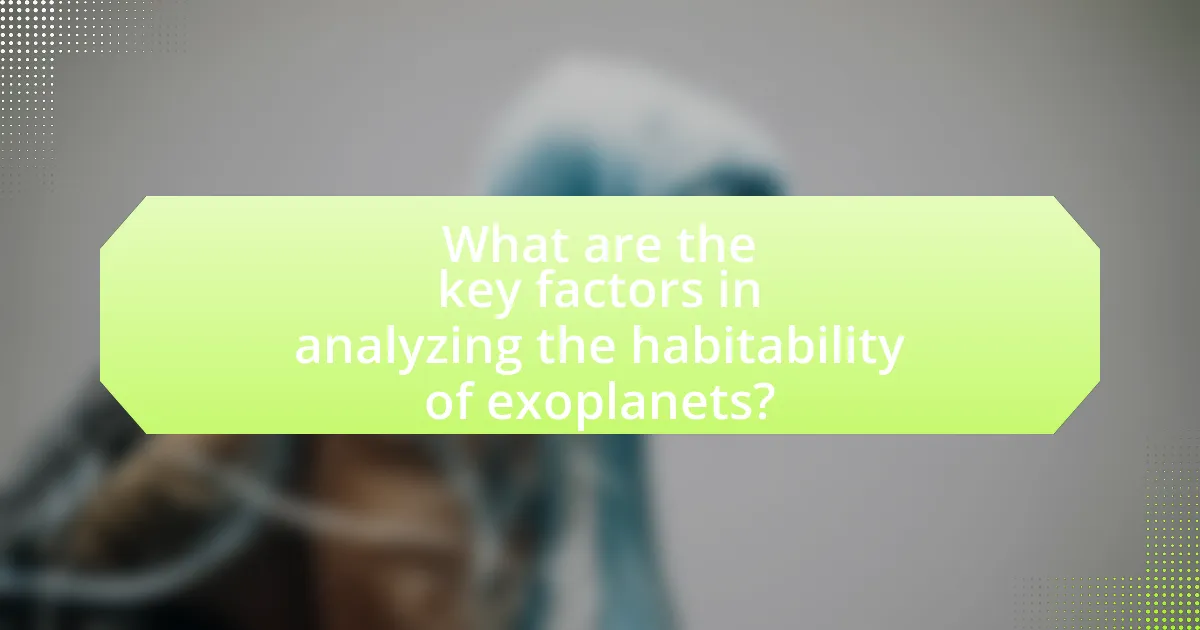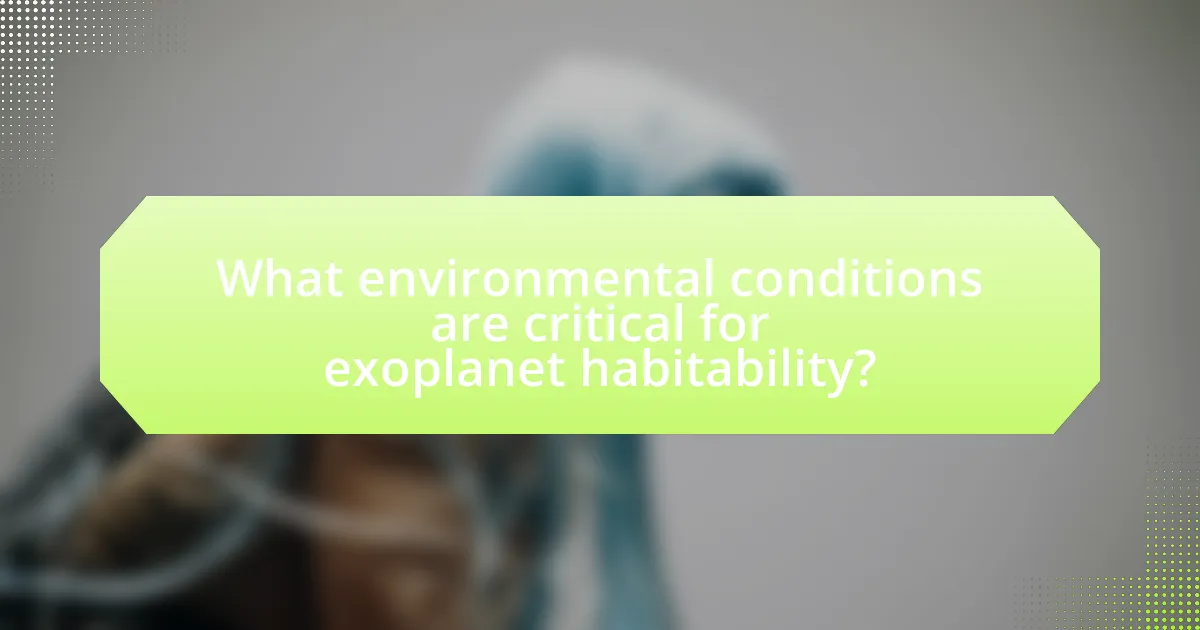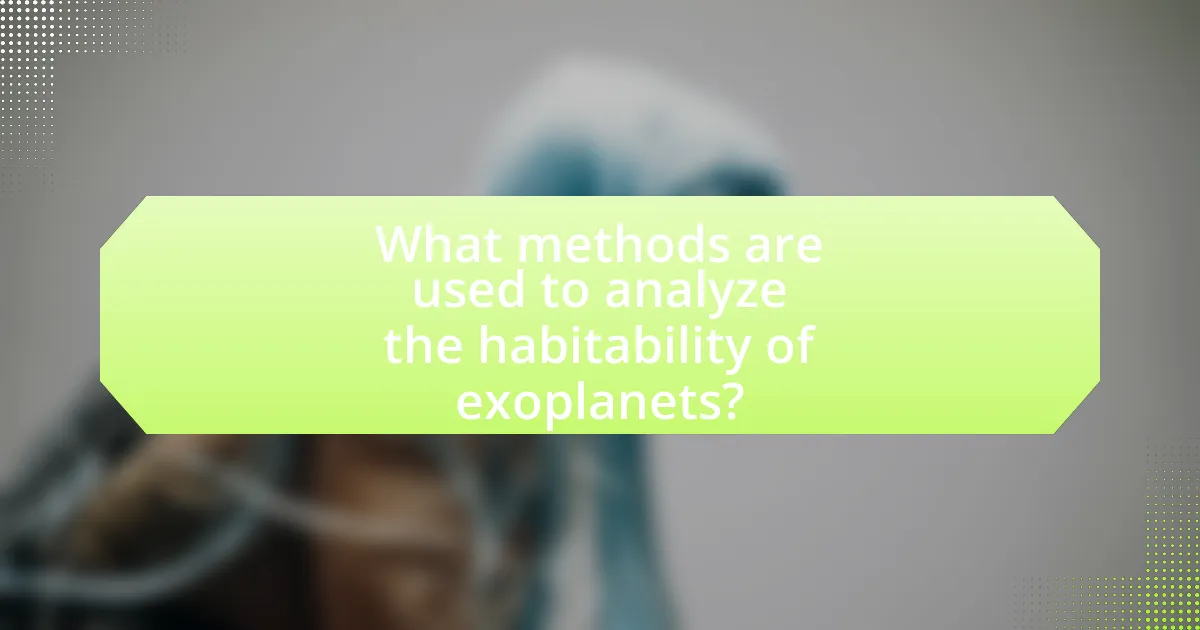The article focuses on analyzing the habitability of exoplanets, emphasizing key factors such as the presence of liquid water, distance from the host star, atmospheric composition, and geological activity. It defines habitability in terms of conditions that can support life, primarily based on the existence of liquid water and a stable atmosphere. The article discusses the significance of the “Goldilocks Zone,” the impact of stellar types on habitability, and the essential elements and compounds necessary for life. Additionally, it explores methods for assessing habitability, including atmospheric characterization and climate modeling, while highlighting advancements in technology and future missions aimed at further investigating exoplanetary conditions.

What are the key factors in analyzing the habitability of exoplanets?
The key factors in analyzing the habitability of exoplanets include the presence of liquid water, the planet’s distance from its star, atmospheric composition, and geological activity. Liquid water is essential for life as we know it, and its presence is often determined by the planet’s location within the habitable zone, where temperatures allow for liquid water to exist. The distance from the star affects the planet’s temperature and climate, influencing its ability to support life. Atmospheric composition is crucial, as a suitable atmosphere can protect life from harmful radiation and maintain surface pressure conducive to liquid water. Geological activity can also play a role in recycling nutrients and maintaining a stable environment. These factors are supported by studies such as those conducted by the Kepler Space Telescope, which identified numerous exoplanets in habitable zones, reinforcing the importance of these criteria in habitability assessments.
How do scientists define habitability in the context of exoplanets?
Scientists define habitability in the context of exoplanets as the potential for an environment to support life as we know it, primarily based on the presence of liquid water, suitable temperatures, and a stable atmosphere. This definition is grounded in the understanding that life on Earth requires these conditions to thrive, leading researchers to focus on the “habitable zone,” which is the region around a star where temperatures allow for liquid water to exist. Studies, such as those by Kopparapu et al. (2013) in “A Revised Estimate of the Inner Edge of the Habitable Zone for F, G, K, and M Dwarfs,” provide empirical data supporting the criteria for habitability, emphasizing the importance of stellar type, planetary distance, and atmospheric composition in determining whether an exoplanet can sustain life.
What criteria are used to assess the habitability of an exoplanet?
The criteria used to assess the habitability of an exoplanet include its distance from the host star, atmospheric composition, surface temperature, and the presence of liquid water. The distance from the host star determines whether the planet lies within the habitable zone, where conditions may allow for liquid water to exist. Atmospheric composition is crucial as it affects temperature regulation and protection from harmful radiation; for instance, a planet with a thick atmosphere rich in greenhouse gases can maintain surface temperatures conducive to life. Surface temperature must fall within a range that supports liquid water, typically between 0°C and 100°C. The presence of liquid water is often considered the most critical factor, as it is essential for all known forms of life. These criteria are supported by studies such as those conducted by the Kepler Space Telescope, which identified numerous exoplanets in habitable zones, reinforcing the importance of these factors in determining habitability.
Why is the concept of the “Goldilocks Zone” important for habitability?
The concept of the “Goldilocks Zone” is important for habitability because it defines the region around a star where conditions are just right for liquid water to exist on a planet’s surface. This zone is crucial because liquid water is essential for life as we know it, serving as a solvent for biochemical reactions. Research indicates that planets within this zone, such as Earth, have the potential to support diverse ecosystems, while those outside it may be too hot or too cold for water to remain liquid, thus limiting the possibility of life.
What role does stellar type play in exoplanet habitability?
Stellar type significantly influences exoplanet habitability by determining the star’s temperature, luminosity, and lifespan, which in turn affect the potential for liquid water and stable climates on orbiting planets. For instance, stars classified as K-dwarfs provide a stable environment with a long lifespan, allowing planets in their habitable zones to develop and sustain life over billions of years. In contrast, hotter stars like O and B types have shorter lifespans and emit intense radiation, which can strip away planetary atmospheres and hinder habitability. Research indicates that M-dwarfs, while abundant, present challenges due to their flares, which can impact the atmospheres of nearby planets. Thus, the stellar type is a critical factor in assessing the likelihood of life-supporting conditions on exoplanets.
How do different types of stars affect the potential for life on orbiting planets?
Different types of stars significantly influence the potential for life on orbiting planets through their luminosity, stability, and lifespan. For instance, stars like G-type (similar to the Sun) provide a stable environment with a suitable habitable zone where liquid water can exist, essential for life as we know it. In contrast, M-type stars, or red dwarfs, have long lifespans but emit less energy, leading to tighter habitable zones that may expose planets to tidal locking, potentially limiting habitability. Furthermore, O-type and B-type stars are massive and emit high levels of radiation, which can strip away planetary atmospheres, making it difficult for life to develop. Research indicates that the habitable zone around different star types varies; for example, the habitable zone for a G-type star is approximately 0.95 to 1.37 astronomical units, while for an M-type star, it is much closer, often within 0.1 to 0.2 astronomical units. This variability in habitable zones directly impacts the likelihood of life on orbiting planets.
What are the implications of stellar radiation on exoplanet atmospheres?
Stellar radiation significantly influences exoplanet atmospheres by affecting their composition, temperature, and potential for habitability. High-energy radiation from stars can lead to atmospheric erosion, particularly in planets with weak magnetic fields, as seen in studies of exoplanets like HD 189733b, where intense stellar winds strip away the atmosphere. Additionally, stellar radiation can drive photochemical reactions, altering the chemical makeup of the atmosphere, which impacts the greenhouse effect and climate stability. For instance, ultraviolet radiation can break down molecules like water vapor, affecting the planet’s ability to retain heat and sustain liquid water, a critical factor for habitability.
How does planetary composition influence habitability?
Planetary composition significantly influences habitability by determining the availability of essential elements and compounds necessary for life. For instance, a planet with a rocky composition rich in silicates and metals can support a solid surface and an atmosphere conducive to liquid water, which is vital for life as we know it. Additionally, the presence of elements like carbon, hydrogen, nitrogen, oxygen, phosphorus, and sulfur is crucial for the formation of organic molecules and biological processes. Research indicates that planets with a diverse mineralogy can facilitate various geochemical cycles, further enhancing their potential to support life. For example, the presence of water-bearing minerals can indicate past or present water activity, which is a key factor in assessing habitability.
What are the essential elements and compounds for supporting life?
The essential elements and compounds for supporting life include carbon, hydrogen, nitrogen, oxygen, phosphorus, and sulfur, commonly referred to as CHNOPS. These elements are fundamental building blocks of biological molecules such as proteins, nucleic acids, carbohydrates, and lipids. For instance, carbon forms the backbone of organic molecules, while nitrogen is crucial for amino acids and nucleotides. Oxygen is vital for cellular respiration, and phosphorus is a key component of DNA and ATP, the energy currency of cells. Sulfur is important for certain amino acids and vitamins. The presence of these elements and compounds is critical for the biochemical processes that sustain life, as evidenced by their universal occurrence in known life forms on Earth.
How does the presence of water impact the habitability of exoplanets?
The presence of water significantly enhances the habitability of exoplanets by providing a crucial medium for biochemical processes essential for life. Water acts as a solvent, facilitating chemical reactions necessary for the formation of organic molecules, which are the building blocks of life. Additionally, water regulates temperature through its high heat capacity, creating a stable environment conducive to sustaining life. Research indicates that planets within the habitable zone, where liquid water can exist, have a higher likelihood of supporting life forms, as evidenced by the discovery of exoplanets like Kepler-186f, which is located in this zone and shows signs of water presence.

What environmental conditions are critical for exoplanet habitability?
The critical environmental conditions for exoplanet habitability include the presence of liquid water, a stable atmosphere, suitable temperature ranges, and adequate radiation levels. Liquid water is essential as it is a solvent for biochemical reactions necessary for life. A stable atmosphere provides pressure and protects against harmful radiation, while suitable temperature ranges allow for the maintenance of liquid water. Adequate radiation levels ensure that energy from a star is sufficient for photosynthesis without being detrimental to potential life forms. These conditions are supported by the concept of the habitable zone, where conditions are just right for liquid water to exist, as demonstrated by studies of known exoplanets that fall within this zone.
How does atmospheric composition affect the potential for life?
Atmospheric composition significantly affects the potential for life by determining the availability of essential gases, regulating temperature, and influencing chemical processes. For instance, a balanced atmosphere rich in oxygen and nitrogen, like Earth’s, supports aerobic respiration, which is crucial for most complex life forms. Conversely, an atmosphere lacking in oxygen or containing high levels of toxic gases can inhibit life. Additionally, the presence of greenhouse gases, such as carbon dioxide and methane, plays a vital role in maintaining a stable climate, which is necessary for sustaining liquid water—a key ingredient for life. Research indicates that exoplanets with atmospheres similar to Earth’s have a higher likelihood of supporting life, as evidenced by studies of the atmospheres of planets like Venus and Mars, which demonstrate how different compositions can lead to vastly different habitability outcomes.
What gases are essential for sustaining life on exoplanets?
Oxygen, carbon dioxide, and nitrogen are essential gases for sustaining life on exoplanets. Oxygen is crucial for aerobic respiration, carbon dioxide is necessary for photosynthesis, and nitrogen is a key component of amino acids and nucleic acids. The presence of these gases indicates potential biological processes similar to those on Earth, supporting the idea that exoplanets with these gases may harbor life.
How does atmospheric pressure influence habitability?
Atmospheric pressure significantly influences habitability by determining the ability of a planet to retain liquid water, which is essential for life. Higher atmospheric pressure can increase the boiling point of water, allowing it to exist in liquid form at higher temperatures, while lower pressure can lead to water vaporization, making it difficult for life to thrive. For example, Earth’s atmospheric pressure is approximately 101.3 kPa, which supports stable liquid water on its surface, a critical factor for sustaining life. In contrast, planets with very low atmospheric pressure, like Mars, experience rapid water loss and have limited potential for habitability.
What geological factors contribute to the habitability of exoplanets?
Geological factors that contribute to the habitability of exoplanets include tectonic activity, the presence of liquid water, and the composition of the planet’s crust. Tectonic activity facilitates the recycling of nutrients and the regulation of the planet’s climate, which are essential for sustaining life. The presence of liquid water is critical, as it serves as a solvent for biochemical reactions and is necessary for life as we know it. Additionally, the composition of the crust, including the availability of essential minerals and elements, influences the potential for biological processes. Research indicates that planets with active geology and a stable climate, such as those within the habitable zone of their stars, are more likely to support life.
How do tectonic activity and geological processes support life?
Tectonic activity and geological processes support life by facilitating nutrient cycling, regulating climate, and creating diverse habitats. The movement of tectonic plates leads to the formation of mountains, ocean basins, and volcanic activity, which contribute to the distribution of minerals and nutrients essential for biological processes. For instance, subduction zones recycle carbon and other elements, maintaining the carbon cycle critical for life. Additionally, geological processes such as erosion and sedimentation create varied ecosystems, promoting biodiversity. Research indicates that planets with active geology, like Earth, have a higher potential for sustaining life due to these dynamic processes.
What role does magnetic field strength play in protecting life?
Magnetic field strength plays a crucial role in protecting life by shielding planets from harmful solar and cosmic radiation. A strong magnetic field deflects charged particles from the solar wind, preventing them from stripping away the atmosphere and exposing the surface to radiation that can be detrimental to biological processes. For instance, Earth’s magnetic field protects its atmosphere and, consequently, life by reducing the impact of solar storms, which can otherwise lead to increased radiation levels on the surface. Studies have shown that planets with weak or no magnetic fields, like Mars, experience significant atmospheric loss and higher radiation exposure, which are detrimental to potential life forms.
How do climate and weather patterns impact exoplanet habitability?
Climate and weather patterns significantly impact exoplanet habitability by influencing temperature, atmospheric composition, and the presence of liquid water. These factors are crucial for sustaining life as we know it. For instance, a stable climate with moderate temperatures can allow for the existence of liquid water, which is essential for biological processes. Additionally, weather patterns, such as wind and precipitation, can affect the distribution of nutrients and energy, further influencing the potential for life. Research indicates that planets within the habitable zone of their stars, where conditions are just right for liquid water, are more likely to support life, as evidenced by the discovery of exoplanets like Kepler-186f, which has conditions similar to Earth.
What are the effects of extreme weather on potential life forms?
Extreme weather significantly impacts potential life forms by creating harsh environmental conditions that can hinder survival and adaptation. For instance, extreme temperatures, whether excessively hot or cold, can lead to cellular damage, disrupt metabolic processes, and limit the availability of essential resources like water and nutrients. Additionally, severe weather events such as hurricanes or droughts can destroy habitats, reduce biodiversity, and lead to population declines. Research indicates that organisms in extreme environments, such as extremophiles, have adapted to survive under such conditions, demonstrating that while extreme weather poses challenges, it can also drive evolutionary adaptations.
How do seasonal changes influence habitability on exoplanets?
Seasonal changes significantly influence habitability on exoplanets by affecting temperature, climate patterns, and the availability of liquid water. These variations can create diverse environments that may support different forms of life. For instance, exoplanets with axial tilts similar to Earth experience seasons that can lead to fluctuations in temperature and precipitation, which are crucial for maintaining ecosystems. Research indicates that planets within the habitable zone, where conditions allow for liquid water, can experience seasonal changes that enhance biological activity, as seen in models simulating Earth-like conditions. Such seasonal dynamics can also impact atmospheric composition and weather systems, further influencing the potential for life.

What methods are used to analyze the habitability of exoplanets?
The methods used to analyze the habitability of exoplanets include atmospheric characterization, the study of stellar radiation, and the assessment of planetary conditions such as temperature and pressure. Atmospheric characterization involves analyzing the composition of an exoplanet’s atmosphere through techniques like transmission spectroscopy, which can reveal the presence of gases like oxygen and methane, indicators of potential biological activity. The study of stellar radiation examines the type and intensity of radiation emitted by the host star, which affects the planet’s climate and potential for liquid water. Additionally, assessing planetary conditions involves modeling the planet’s surface temperature and pressure to determine if they fall within the range suitable for life, often referred to as the “Goldilocks zone.” These methods collectively provide a comprehensive understanding of an exoplanet’s potential habitability.
How do astronomers detect exoplanets and assess their habitability?
Astronomers detect exoplanets primarily through methods such as the transit method and radial velocity method. The transit method involves observing the dimming of a star’s light as a planet passes in front of it, allowing astronomers to determine the planet’s size and orbital period. The radial velocity method measures the star’s wobble due to gravitational pull from an orbiting planet, providing information about the planet’s mass.
To assess habitability, astronomers analyze factors such as the planet’s distance from its star, which determines its position in the habitable zone where liquid water could exist. They also evaluate the planet’s atmosphere for essential elements like oxygen and carbon dioxide, which are indicators of potential life. For instance, the discovery of exoplanets like Kepler-186f, located in the habitable zone of its star, demonstrates the application of these methods in identifying potentially habitable worlds.
What techniques are used to study exoplanet atmospheres?
Techniques used to study exoplanet atmospheres include transmission spectroscopy, emission spectroscopy, and direct imaging. Transmission spectroscopy analyzes the light that passes through an exoplanet’s atmosphere during a transit, allowing scientists to identify chemical signatures based on absorption lines. Emission spectroscopy measures the light emitted by the atmosphere when the planet is behind its star, providing insights into temperature and composition. Direct imaging captures light reflected from the exoplanet, enabling the study of atmospheric features and weather patterns. These methods have been validated through observations from telescopes like Hubble and the upcoming James Webb Space Telescope, which enhance our understanding of exoplanetary atmospheres.
How do models simulate conditions on exoplanets?
Models simulate conditions on exoplanets by utilizing complex algorithms that incorporate physical laws, atmospheric chemistry, and planetary dynamics. These models often rely on data from telescopes and space missions to gather information about an exoplanet’s mass, radius, and distance from its star, which are crucial for determining temperature and atmospheric composition. For instance, climate models can simulate temperature variations and weather patterns by applying principles of thermodynamics and fluid dynamics, allowing researchers to predict whether conditions could support liquid water, a key factor for habitability. Additionally, radiative transfer models assess how stellar radiation interacts with an exoplanet’s atmosphere, influencing surface conditions. This approach is validated by comparing model predictions with observed data from known exoplanets, enhancing the accuracy of habitability assessments.
What advancements are being made in exoplanet habitability research?
Recent advancements in exoplanet habitability research include the development of more sophisticated models for atmospheric analysis and the use of machine learning to identify potentially habitable planets. Researchers have improved techniques for detecting biosignatures in exoplanet atmospheres, such as the study published in Nature Astronomy by Schwieterman et al. (2018), which outlines methods for distinguishing between false positives and genuine signs of life. Additionally, the James Webb Space Telescope has enhanced our ability to analyze the chemical composition of exoplanet atmospheres, providing critical data on conditions that may support life. These advancements collectively contribute to a more nuanced understanding of which exoplanets may be capable of sustaining life.
How are new technologies improving our understanding of exoplanets?
New technologies are enhancing our understanding of exoplanets by enabling more precise detection and characterization methods. For instance, advancements in transit photometry, such as those used by the Kepler Space Telescope, allow scientists to identify exoplanets by measuring the dimming of stars as planets pass in front of them. This method has led to the discovery of thousands of exoplanets, providing data on their sizes and orbital periods. Additionally, spectroscopic techniques, including those employed by the James Webb Space Telescope, facilitate the analysis of exoplanet atmospheres, revealing the presence of key molecules like water vapor and carbon dioxide. These technologies collectively improve our ability to assess the habitability of exoplanets by providing critical information about their composition and environmental conditions.
What future missions are planned to explore exoplanet habitability?
The future missions planned to explore exoplanet habitability include NASA’s James Webb Space Telescope (JWST), set to launch in December 2021, which will analyze the atmospheres of exoplanets for signs of habitability. Additionally, the European Space Agency’s Ariel mission, scheduled for launch in 2029, aims to study the composition of exoplanet atmospheres and their potential for supporting life. These missions are designed to gather data on atmospheric conditions, chemical compositions, and other factors critical for assessing habitability, thereby advancing our understanding of potentially habitable worlds beyond our solar system.
What practical steps can be taken to further investigate exoplanet habitability?
To further investigate exoplanet habitability, scientists can utilize advanced telescopes to analyze the atmospheres of these planets for biosignatures. This involves using instruments like the James Webb Space Telescope, which can detect chemical compositions such as oxygen, methane, and carbon dioxide that may indicate biological processes. Additionally, conducting detailed simulations of planetary climates can help assess the potential for liquid water, a crucial factor for life. Research has shown that planets within the habitable zone of their stars, where conditions may allow for liquid water, are prime candidates for such studies. Furthermore, ongoing missions like the Transiting Exoplanet Survey Satellite (TESS) are crucial for identifying new exoplanets that warrant further investigation.
How can citizen science contribute to exoplanet research?
Citizen science can significantly contribute to exoplanet research by enabling large-scale data collection and analysis through public participation. Projects like the Planet Hunters initiative allow volunteers to analyze light curves from stars to identify potential transits of exoplanets, which has led to the discovery of numerous new planets. For instance, the Kepler Space Telescope’s data was analyzed by citizen scientists, resulting in the identification of thousands of exoplanet candidates, showcasing the effectiveness of public involvement in scientific research.
What are the best practices for analyzing exoplanet data?
The best practices for analyzing exoplanet data include employing robust statistical methods, utilizing multiple detection techniques, and cross-validating findings with independent datasets. Robust statistical methods, such as Bayesian analysis, help quantify uncertainties and improve the reliability of results. Utilizing multiple detection techniques, like transit photometry and radial velocity measurements, enhances the chances of confirming exoplanet existence and characterizing their properties accurately. Cross-validation with independent datasets, such as those from different telescopes or missions, ensures that findings are not artifacts of a single method or instrument. These practices are supported by studies like those from the Kepler mission, which demonstrated the importance of combining data from various sources to improve the understanding of exoplanet characteristics and their potential habitability.
